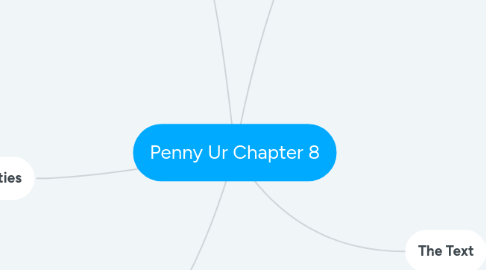
1. The Task
1.1. Expectations
1.1.1. Students should expect what kind of task is coming
1.2. Purpose
1.2.1. The purpose should be understood
1.3. Selective listening
1.3.1. Listen to what the students KNOW
1.4. Ongoing listener response
1.4.1. Use less authentic materials
1.5. Exceptions
1.5.1. No-task
1.5.2. No preparation
1.6. Tips
1.6.1. Try it out
1.6.2. Don't overteach vocabulary
1.6.3. Don't overload
2. Types of activities
2.1. No overt response
2.1.1. Stories, songs, entertainment
2.2. Short -||-
2.2.1. Obeying instructions, ticking, true/false
2.2.2. Detecting mistakes, cloze
2.2.3. Skimming, scanning
2.3. long
2.3.1. Answering, paraphrasing, summarizing
2.3.2. long gapfilling
2.4. Extended
2.4.1. Problem solving, interpretation
2.4.2. Dicto-gloss
3. Adapting activities
3.1. Preparation, small changes may be needed
3.2. Tasks may need redesign (EX.1)
3.3. Ex. 2: not suitable
3.4. Ex. 3: improvements needed
4. Goals & Problems
4.1. Goals
4.1.1. Main goal
4.1.1.1. Enable students to internatioanally cope with real life situations
4.1.2. Why?
4.1.2.1. English: international lingua franca
4.1.2.2. Today's writers are aware of the problems
4.2. Problems
4.2.1. Speech is typically
4.2.1.1. Informal
4.2.1.2. Improvised
4.2.2. Speaker is usually seen
4.2.3. Language is too formal
4.2.4. Students listening to each other is not useful practice
5. The Text
5.1. Brevity
5.1.1. Speakers are often brief, not in whole sentences
5.2. Pronunciation problems
5.2.1. Words are often differently pronounced than they are written
5.3. Vocabulary
5.3.1. Often informal
5.4. Grammar
5.4.1. Somewhat ungrammatical
5.5. Noise
5.5.1. Hard to distinguish
5.6. Redundancy
5.6.1. Repetition, Paraphrasing
5.6.2. More information than needed
5.7. Varied accents
5.7.1. wide variety of accents
5.8. Facial expression
5.8.1. speaker visible through video or is present
5.9. Tips
5.9.1. Don"t just use recordings, bring in real people
5.9.2. Teacher talk
5.9.3. Bring visitors
5.9.4. Developing reading-aloud skills
5.9.5. Varied sample of texts
